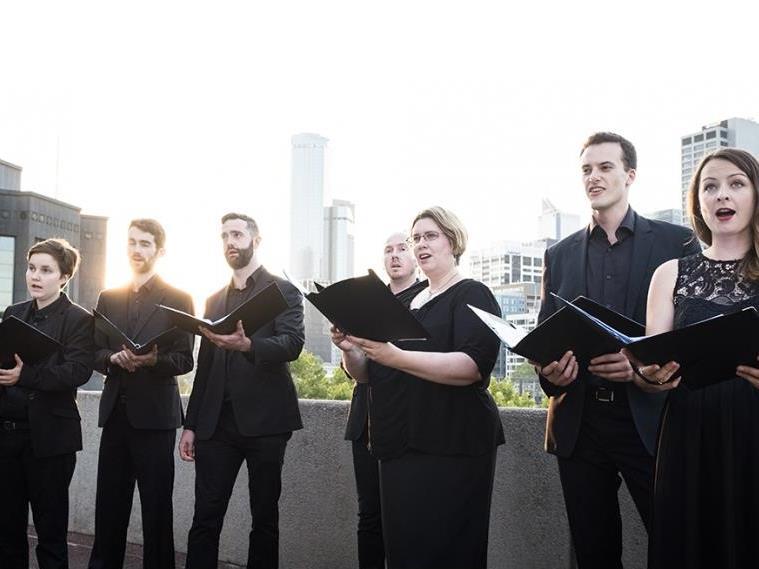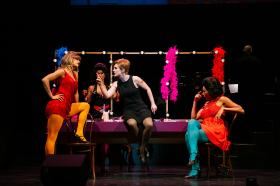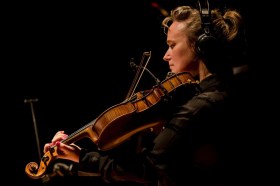Voices o’er the Waves presented by The Consort of Melbourne. Image courtesy of Melbourne Recital Centre.
Following its recital in June based on the theme of fire (Flames Within), The Consort of Melbourne delivered another engaging performance to an almost full Salon on Wednesday night, this time gathering another interesting collection of works inspired by water. The program canvassed several of the theme’s symbolic associations ranging from purification and appeasement through to tempest and hazard.
The recital opened with Jonathan Wallis’s Ave maris stella that engages an extended concept of species counterpoint (musical lines woven together) setting this well-known, eighth-century plainchant. Now a Classics lecturer at the University of Tasmania, Wallis wrote this subtle, restrained yet deeply effective work for the choir of Ormond College whilst studying at The University of Melbourne. From the outset the nine singers, with Steve Hodgson providing understated direction from within the ensemble, had difficulties with blend, tuning and accuracy of starts and ends of phrases; nothing overly concerning, but with the calibre of these musicians it could have been perfect.
There are rich pickings from Claudio Monteverdi’s books of madrigals on the theme of water. Ecco mormorar l’onde from Book 2 was selected, a setting of Tasso taking the sight of dawn coolly reflected on the sea as appeasement for a ‘burnt heart’. The work was expressively sung, though Italian word rhythm, vowel linking and language accent could have all been polished. From the start ensemble was not settled, the work needing to be more ‘sung in’. Accuracy of tuning remained a problem.
The recital improved with the three 16th-Century polyphonic works: Giovanni Pierluigi da Palestrina’s Surge, propera amica mea setting an excerpt from the Song of Solomon, Orlande de Lassus’s Descendit sicut pluvial and Tomás Luis de Victoria’s double-choir setting of Super flumina Babilonis setting Psalms 71 and 137. Each was performed with an easy, open and flowing style with a good, natural pace, carefully shaped phrases through expressive, sincere and convincing direction. Improving matched pure open vowels of the Latin was needed though, and more care taken, particularly by sopranos, in accurately tuning their decorative intervallic cells. There was a tendency for singing too loudly without sufficient dynamic subtlety and variation.
I hear the rain by prolific Dane, Per Nørgård, inspired by his hearing the resonances of a low ‘G’ on an Indian beach followed. This highly atmospheric and effective work, engaging harmonic strands and microtonal singing accompanied by whistling, finger snapping (originally percussion that would have been better still) and other extended techniques recalls the psychological state of isolation in a rain-drenched metropolis. Samuel Barber’s soothing To be sung on the water demonstrated an improved rapport and more unified sound as it depicted two lovers rowing together on a river. Through the persistent separation of upper and lower voices the work suggests a budding if not yet realised love. More sinister aspects of the ocean first became evident in Full fathom five by Swiss composer Frank Martin, a setting of Ariel’s song from Shakespeare’s The Tempest. Following this came a most unusual (and lengthy) composition by Estonian composer Veljo Tormis: Incantatio maris aestuosi (Incantation for a stormy sea) commissioned in memoriam of victims of the MS Estonia, a ferry that sank during a stormy night in the Baltic Sea in 1994 costing hundreds of lives. The work was composed for a much larger chamber choir than this, the heft of its enormous dynamic range was well beyond the capabilities of this ensemble’s nine voices.
After the raging tempest, Frederick Delius’s wordless To be sung of a Summer night on the water came as a balm though blend and smoothness might have been improved as the Consort in six parts conveyed a dreamy landscape floating in a warm evening breeze. A member of the Consort but not performing on this occasion, tenor, conductor and composer Dan Walker was represented with a significant and highly expressive work titled Dusk that sets Australian poetry by John Blight, portraying voices calling across water at dusk with a Keatsian symbolism of birdlife affording a final acceptance of the passing of life.
With very few performances each year and with a different line-up of singers for each concert, it is questionable if The Consort of Melbourne can ever develop the mature and unified ‘voice’ it deserves. It should perform more often and with programs containing larger-scale works so it can develop and demonstrate its style for each period. Dégustation programs such as this, where repertoire lurches back and forth across centuries, only provide frustrating glimpses of what the ensemble is capable of and what audiences might hope for.
Rating: 3 ½ stars out of 5
The Consort of Melbourne – Voices o’er the Waves
Presented by The Consort of Melbourne and Melbourne Recital Series
Steven Hodgson, bass, artistic director and conductor
Megan Nelson, soprano
Kristy Biber, soprano
Miranda Gronow, alto
Hannah Pietsch, alto
Timothy Reynolds, tenor
Christopher Roache, tenor
Lucien Fischer, bass
Jerzy Kozlowski, bass
Salon, Melbourne Recital Centre
Wednesday, 9 November, 2016






